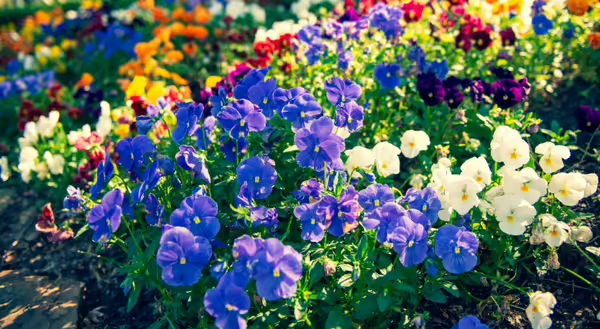
As winter slowly fades, every gardener is getting anxious for spring—to dig their hands into the dirt, smell the fresh-cut grass, and fill their containers with annual combinations bursting with color. While it is still a little too early to plant most annual plants, there are a few you can plant now that will tolerate the cooler spring-time temperatures.
Cool-season annuals thrive in cool weather, growing best in spring and fall, and will tolerate a light frost. They can be used to extend the growing season, add color to the garden before other plants even think about showing up for the season, and make beautiful companions for blooming spring bulbs in the landscape.
At the garden centers right now are pansies, violas, ranunculus, and primrose. All of these are available in a wide range of colors and combinations. The ever-favorite pansies and violas have cheery, flat blooms that can resemble faces popping up out of the foliage. Ranunculus has the most perfect rose-like flowers, and primrose offers large amounts of bright blooms on a rosette of dark green foliage.
Other annuals that may tolerate cooler temperatures are sweet alyssum, snapdragon, nasturtiums, and dianthus. Cool-season plants grown for their foliage are ornamental kale, swiss chard, and dusty miller.
When planting cool-season annual plants in a container, add interesting twigs, like birch, contorted filbert, or willow to the center of the arrangement for some height since many of these are shorter growing plants. If planting them in-ground, group plants in masses to create large waves of color amongst spring-blooming shrubs and bulbs.
Besides being a decorative addition to your garden, cool-season annuals offer pollinators much-needed nectar in the early spring. Pollinators start emerging in early March and start looking for food sources to survive. There are very few flowering plants blooming for them at this time, except spring-blooming bulbs like grape hyacinth and crocus.
Once temperatures warm up, many cool-season plants will stop blooming and fade out. Then it is time to plan your warm-temperature-loving annuals and tropicals. If you plant these before the threat of frost has passed, you run the chance of them being damaged by cold or having to cover or bring them inside multiple times.
Help the bees and add some color to your landscape or patio this spring!
For more recommendations on new or unique annuals to plant this spring, check out University of Illinois Extension’s website “Beyond Impatiens and Petunias” at extension.illinois.edu/beyond.